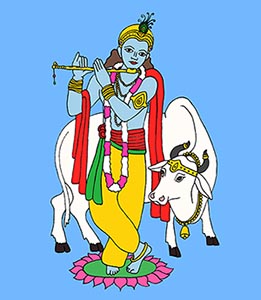
The Epic of Krishna & His Mantras
Krishna’s life and teachings are primarily recorded in the Mahabharata, Bhagavata Purana, and the Bhagavad Gita. He is depicted as a divine being who takes birth to restore dharma (righteousness). He is the wise charioteer of Arjuna in the Bhagavad Gita, where he reveals profound philosophical truths about duty, devotion, and the nature of existence.
Krishna is a multifaceted deity who embodies love, wisdom, and power. His teachings in the Bhagavad Gita form the core of bhakti (devotional) traditions and emphasize the importance of surrendering to God. Krishna’s impact on Hinduism is undeniable. His teachings continue to guide millions, and his divine persona remains a symbol of love, righteousness, and spiritual wisdom.
Share this page with a friend!
Watch nearly 400 videos on the Vocal Medicine Channel!
Epic of Krishna and Arjuna: Bhagavad Gita
The following distillation of the story line and philosophy of the Bhagavad Gita was created from a detailed outline by Jake Fleming, condensed from a translation by Gavin Flood & Charles Martin. Jake is a musician, producer, yoga enthusiast and student of life and spirituality. He has released a series of instrumental meditative works: Elephants in Space, Flute Meditations, Atmananda, and Dancing Roots. Jake’s music can be found on Spotify, YouTube and on his website JakeSongs.com.
Setting for the Bhagavad Gita
The warrior Arjuna is presented with a paradox. As a warrior, he is required to go to battle. However, fulfilling his duties will end the lives of his relatives and loved ones. Although he understands that the nature of physical beings is death, he cannot bear this reality. He collapses.
Krishna Teaches Arjuna
Arjuna’s friend and teacher is Krishna. Krishna explains that the vital force cannot be extinguished, even in death. Arjuna must not turn from righteous warfare. This is Arjuna’s nature. To turn from battle would be a disgrace born from succumbing to fear. Arjuna must recognized that pleasure is the same as pain. It is action that is important, not the fruit of action.
Achieving Equanimity
The resolute, higher mind is undivided. If you are yoked by the higher mind, you are no longer bound by the fruit of action. This requires one to withdraw the senses. Once unyoked from hate and passions, you can engage with control,, unmoved by success or failure. You are no longer agitated by desires, suffering, anger or fear.
Taking Action in the World
As the Bhagavad Gita continues, Krishna elaborates on the need to do one’s duty in the world. One must take part in action to contribute and sacrifice. Even though Krishna himself has no need to do anything, he still acts without attachment to any needs. In this way, a leader is an example for followers. The appropriate actions for each person are determined by their own nature. it is better to do one’s own duty ineptly than to do another’s duty well. Make sure to act without personal desire.
Krishna Explains the Practice of Yoga
There is a path of action and the path of renunciation. Both paths will lead to bliss. If one attains union with Brahman, one gains the ability to endure suffering, rage, and desire. One sees the same in all things. The yogi is fixed upon the Self, removing the veil of ignorance and cleansing impurities.
Coming to Know Krishna
Souls that are bound with Krishna are connected to Light, Sound, fragrance and radiance. Surrender allows one to pass beyond illusion. Krishna is honored by all seekers: knowledge seekers, wealth seekers, and wise men. A steadfast wise man is particularly dear to Krishna.
Understanding the Universe
The physical being is transient. Spirit is divine, and Brahman is the essence of Self. To focus on Krishna is to become him when the spirit leaves the body. Otherwise, a person focused on duality and illusion will return to this world after death. Thus, the yogi sacrifices to go to the highest place.
Author Kathleen Karlsen
Kathleen Karlsen is a musician, artist, writer and speaker. She is the author of two books (Flower Symbols and Vocal Medicine) and over 200 articles. Kathleen, her husband Andrew, and their five children live in Bozeman, Montana. More about Kathleen Karlsen.
Krishna Mantra Article Summary
Krishna is one of the most significant deities in Hinduism. He is the eighth incarnation of Vishnu, one of the three persons of the Hindu trinity. He is the wise charioteer of Arjuna in the Bhagavad Gita, where he reveals profound philosophical truths about duty, devotion, and the nature of existence.





